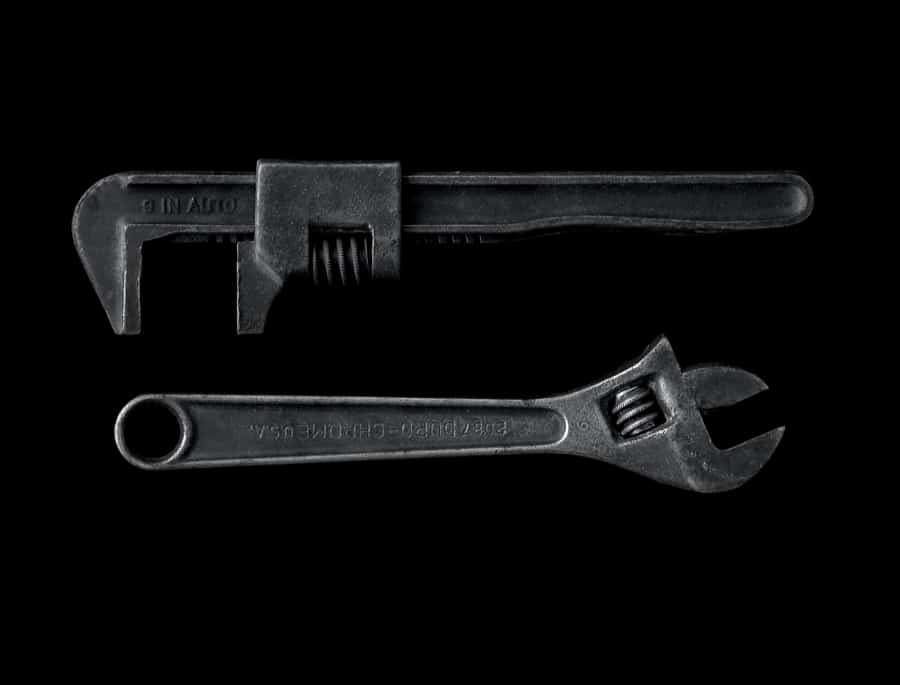Lawnmowers are an incredibly useful and time-saving landscaping tool. However, like with most power tools, they can pose serious health and safety risks when used improperly or when they are faulty.
Mower blades can be as tight as desired for machines with ‘give’ mechanisms built in. Many mowers have manufacturer specified foot-pound torque values. For zero turn and lawn tractors 65 to 100 ft-lb is an acceptable level. Tightness for push and self propelled mowers range from 30-60 ft-lb.
Today, I focus on the most dangerous part of a lawnmower…the blades. We discuss how tight the blades should be when the mower deck is disengaged, as well as whether they should be allowed to spin freely in place.

Contents
How Tight Is Too Tight For Lawn Mower Blades?
The average Joe with no clue on how mowers work may have the belief that the blade on a lawnmower should be completely unmovable from its position when the mower isn’t in operation. Many people believe the engine’s power alone is what should drive the blade(s), which is understandable.
However, this belief is false.
While lawnmower blades shouldn’t be spinning freely, they should still have give when you push or pull them. This give is necessary as it is a safety measure that will protect the blades and even the clutch from permanent damage if the blades hit a hard object like a rock or slab.
When it comes to tightening the blade’s position, your first port of call is your product’s instruction manual. Some manufacturers have an in-built “give” mechanism that works regardless of how tightly you screw the blade in place.
This is usually the case if the manual doesn’t specify how tight the blade should be screwed in. However, it’s a good idea to contact them or the dealer to be sure.
On the other hand, other manufacturers specify a torque value, usually in foot-pounds. There’s no universal value for any class of lawnmower, but there are various ranges.
- Mower blades on zero-turns and garden tractors have a range of 65 and 100 ft-lb. These values are usually dependent on the size of the blade and decks. Some of the biggest z-turn mowers have 100”+ decks!
- Power push and self-propelled mowers typically range from 30 to 60 ft-lb. Again, this can depend on the size and heaviness of the blades.
- Reel mowers should be tightened as much as possible. The rotation of reel blades is entirely dependent on the movement of the mower.
The easiest way to determine a torque value is to use a torque wrench (Amazon link). You can also wing it with a regular wrench if you’re confident enough, but that increases the risk of over-tightening, which can damage the screw.
The blade will also be deprived of the collision-give, which increases the risks of damage if it comes into contact with something hard.
Even worse is the risk of under-tightening, which can result in the blade(s) flying off! Most mowing decks are designed not to be breached by the blade made for the mower, but that doesn’t prevent the mower from tipping or the blade slinging free from under the deck.
To learn more about mower blades, see my other articles here…
- How Do I Make My Lawn Mower Blade Spin Faster?
- What Are Lawn Mower Blades Made Of?
- How Fast Does A Lawn Mower Blade Spin?
Should Lawn Mower Blades Spin Freely?
The answer to this is actually in two parts. It is not an answer that relies on ‘it depends’ in reference to the blade spin itself. Though it does depend on the type of mower it is attached to.
Lawn mower blades should not spin freely on mowers with belt driven systems. They have collision variances, but are directly connected to the motor for power. Blades do spin freely on mowers designed with a clutch at times and are not directly dependent on the engine.
Blades on gearless mowers should not move freely at all because their movement is directly dependent on the running of the engine. The blades are held by a belt system that connects directly to the motor. They must only move to the extent of the collision give we discussed earlier.
A freely spinning blade on such a mower may be a sign of a loose connection to the shafting point. This is very bad because the continued operation could eventually lead to the blade flying off and causing unimaginable damage.
Mowers with a clutch should have blades that spin freely. Blade operation is not dependent on the engine, as the operator can engage or disengage the mower deck and belts anytime. In fact, if your mower blades are not moving freely, it may point to problems with your mower’s transmission.
Can A Lawn Mower Blade Be Too Sharp?
Most people should use sharp, but thick, blades because they will last longer than the razor-thin varieties, which require regular sharpening.
Lawnmower blades can be too sharp for long-term use. An ideal blade angle is 35 degrees. The thinner the edge of the blade becomes, the more fragile it is, especially with blades made of brittle metal. However, some experienced landscapers may make use of extra sharp blades from time to time.
The typical homeowner just wants to bring out the old mower once in a while and trim the grass. Frequent sharpening could become annoying to you, while not sharpening thin blades enough could be a health hazard for your lawn. Dull blades tend to tear the grass, rather than cut it, and this leaves it vulnerable to infection and fungi.
If the blade is secured at the right tightness, the blade is sharpened at the proper angel, and care is taken not to mow over hard objects, a mower should be in optimal performance conditions for quite some time.
The ideal sharpening angle range is 30-40 degrees. Too low is too sharp and too high is too dull. A grinder is an ideal tool for the job, and several good ones are available on Amazon. You can also go old-school with a whetstone.
Here are some pro tips for the best way to sharpen the blades for various scenarios:
- For dense grass with lots of twigs and dead leaves, your best approach is a thick and slightly dulled blade. Think of this as a bruising battle, where your mower will need brute force over seamless intricacy.
- Softer grasses and weeds can be done with a sharper blade. However, it’s best to make the lawn is free of sketchy debris.
- Avoid mowing with the blades too close to the ground, as this will accelerate the dulling of the blade. If you are looking to buy a lawnmower, make sure to get one with an adjustable cutting/deck height. We recommend a three-inch cut for decent ground clearance. This height is also best for most lawn grasses.
As you can see, the sharpness of your blades matters in either direction. Too sharp, and the blade will be prone to quicker dulling, especially on impact with tough objects.
Too dull, and you might end up ripping your grass, which produces a sub-standard and disease-prone lawn. Dull blades also require you to make more passes over the grass, which will cost you time and fuel/energy.
At some point, you and your mower blades may reach a point where sharpening just won’t cut it anymore (pun intended). This is when you might want to consider replacing the blades entirely. Most manufacturers sell and even install replacement blades for their machines, so feel free to contact them when you need to change.
The Final Touches On How Tight Lawn Mower Blades Should Be…
Some mowers have built in safety mechanisms to protect against blade collisions with hard objects. Others have recommended torque values that blades should be tightened to in order for blades to operate safely.
Proper blade tightening, sharpening, and construction can ensure a fast, clean, and healthy cut for your lawn.
To read more about your lawn mower’s blades, see my other articles…
- How Do I Make My Lawn Mower Blade Spin Faster?
- What Are Lawn Mower Blades Made Of?
- How Fast Does A Lawn Mower Blade Spin?
References
https://backyardgadget.com/lawn-mower-blades-loose-or-tight/

